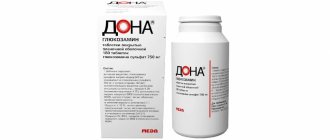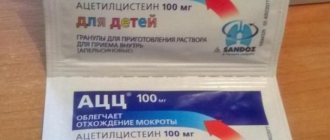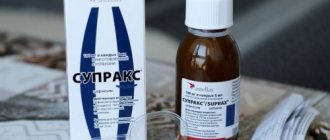Buy Viusid powder for preparing a solution inside a pack. 3.2g No. 21 in pharmacies
Compound:
Glucosamine (700mg), arginine (700mg), glycine (400mg), malic acid (350mg), glycyrrhizic acid (925mg), vitamin C (20mg), zinc sulfate (5mg), vitamin B5 (2mg), vitamin B6 (0. 6 mg), folic acid (70 µg), vitamin B12 (0.4 µg), lemon and mint flavors, maltodextrin, saccharin, sodium methylparaben.
Replenishes the body's daily need for essential vitamins, microelements and amino acids. 1 sachet contains in % of the daily requirement: vitamin B6 - 30%, vitamin B12 - 14%, vitamin B5 - 40%, folic acid - 35%, ascorbic acid - 29%, zinc sulfate - 41%, arginine - 11%, glycine – 11%.
Viusid is recommended as a biologically active food supplement - a source of glycyrrhizic acid, glucosamine, an additional source of vitamins B5, B6, C, folic acid, zinc, containing arginine, glycine, malic acid, vitamin B12.
Viusid has a general strengthening effect, increases the body's nonspecific resistance, and supports liver function.
In the production of Viusid, a high-tech method of molecular activation is used, which makes it possible to increase the biological activity of its constituent components.
The biological activity of Viusid is determined by the activity of its constituent components.
Glycyrrhizic acid
- obtained from the Glycyrrhiza glabra plant, has antioxidant, antiviral, anti-inflammatory and anti-allergic effects. Stimulates the synthesis of adrenal hormones, inhibiting the formation of inactive dihydro derivatives. Induces the synthesis of endogenous interferons.
Glucosamine
- the basis of proteoglycans that make up connective tissue, promotes the restoration of connective tissue, restores the cartilaginous surfaces of joints and intervertebral discs, and normalizes metabolism in cartilage tissue. Glucosamine has anti-inflammatory, antioxidant, hepatoprotective and chondroprotective effects.
Vitamin C
(ascorbic acid) is a natural antioxidant that inactivates free radicals, protecting cell membranes from the damaging effects of peroxidation. Promotes the absorption of iron, affects the formation of hemoglobin and the maturation of red blood cells, is necessary for the formation of collagen, activates the activity of the endocrine glands, regulates all types of metabolism and tissue regeneration. Ascorbic acid stimulates humoral and cellular immunity, interferon synthesis and antibody production, and has anti-inflammatory and antiallergic effects.
Folic acid
necessary for the synthesis of proteins and nucleic acids; its deficiency disrupts the normal process of cell division. Folic acid regulates the functions of the hematopoietic organs, in combination with vitamins B6 and B12, prevents the development of atherosclerosis and osteoporosis.
B vitamins
normalize metabolism and the state of the central nervous system, regulate the processes of metabolism of proteins, fats, carbohydrates and nucleic acids, have an antianemic effect, and are necessary for the normal functioning of the immune, hormonal and hematopoietic systems of the body.
Vitamin B6 (pyridoxine)
- regulates protein metabolism, participates in the synthesis and transport of amino acids, in the formation of protein and structural components of the body, nervous system mediators, prostaglandins, necessary for maintaining hormonal balance, an adequate immune response and the formation of red blood cells.
Vitamin B12 (cyanocobalamin)
participates in DNA synthesis, erythropoiesis, the formation of the myelin sheath of nerve fibers, activates the synthesis of methionine, plays an important role in energy metabolism and regulation of immune activity, increases the phagocytic activity of leukocytes, activates the activity of the reticuloendothelial system, and is necessary for the biological oxidation of proteins and fats.
Vitamin B5
is part of coenzyme A, which plays an important role in the metabolism of fats and carbohydrates, energy production, the formation of adrenal hormones and erythropoiesis.
Zinc
necessary for the functioning of the endocrine system, including thymic hormones, insulin, growth hormone and sex hormones. Zinc affects metabolic and immune processes.
Glycine
is a neurotransmitter amino acid, normalizes and activates processes in the central nervous system, regulates the biosynthesis of proteins and other active compounds.
Arginine
– amino acid, is a donor and natural carrier of nitrogen, participates in the synthesis of urea and nitrogen metabolism processes, promotes the synthesis of growth hormone, activates regeneration processes, stimulates the immune system, enhances spermatogenesis, has detoxifying properties, and acts as a hepatoprotector.
Apple acid
is an intermediate product of cellular respiration, activates the oxidative functions of mitochondria, and has an antioxidant effect.
Thus, Viusid is a balanced complex of biologically active components that has a stimulating effect on the body, increasing its adaptive capabilities and resistance to infections.
Viusid increases the body's defenses in various conditions characterized by decreased immune system function.
Clinical studies have shown that Viusid can be used as an adjuvant in the treatment of various viral diseases. Viusid improves the condition of patients, reduces the number and severity of adverse reactions, and supports liver function.
Release form and composition:
Powder for dissolution, 3.2 grams in sachets
How to take, course of administration and dosage:
Adults: 1 sachet 1 time per day with meals, after dissolving the powder in a small amount of water. Duration of treatment is 2 weeks. It is recommended to consult a doctor before use.
Contraindications:
individual intolerance, phenylketonuria, pregnancy, breastfeeding.
Brief indications:
Viusid can be used for a variety of conditions characterized by decreased immune system function
Storage conditions
Store in a cool, dry place out of reach of children.
Not a medicine. Dispensed without a doctor's prescription.
Best before date
3 years.
Viusid 4.5 g No. 1 dosage solution for oral administration pack.
Instructions for medical use of the drug VIUSID Trade name Viusid International nonproprietary name No Dosage form Powder for oral solution 4.5 g Composition One sachet contains active substances: glycyrrhizic acid 46.9 mg, glucosamine 690 mg arginine 720 mg glycine 393 mg ascorbic acid 43 mg pyridoxine hydrochloride 0.59 mg calcium pantothenate 2.2 mg folic acid 0.068 mg cyanocobalamin 0.000395 mg malic acid 704 mg zinc sulfate 5 mg, excipients: maltodextrin (maltitol), lemon flavor (Brasil 162 A), flavoring mint (R 200 AN) sodium methylparaben (E219), neohesperidin, guar gum. Description Yellowish-white powder with a characteristic odor. Pharmacotherapeutic group Immunomodulators. Immunostimulants. ATC code L 03AX Pharmacological properties Pharmacokinetics The effect of the drug is the combined effect of its components, so kinetic observations are not possible. Pharmacodynamics The complex of active components of VIUSID ensures its biological and clinical effectiveness. Glycyrrhizic acid has antiviral, anti-inflammatory, antipruritic and immunomodulatory effects. Acts on different types of DNA and RNA viruses in vitro and in vivo (Varicella zoster; Herpes simplex types 1 and 2; various types of human papillomavirus, including oncogenic ones). Interrupts the replication of viruses in the early stages, causes the virion to exit the capsid, thereby preventing its penetration into cells, which is associated with selective dose-dependent inhibition of phosphorylating kinase P. Interacts with virus structures (possibly with proteins), changing various phases of the viral cycle, which accompanied by irreversible inactivation of viral particles that are in a free state outside the cells. Blocks the introduction of active viral particles into the cell, disrupts the ability of the virus to induce the synthesis of new viral particles. Induces the formation of interferon, which is one of the components of the antiviral effect. Inactivates these viruses in concentrations that are non-toxic for normally functioning cells. Mutant strains of viruses resistant to acyclovir and iodouridine are also highly sensitive to glycyrrhizic acid, like non-mutant strains. The anti-inflammatory activity of glycyrrhizic acid is combined with a stimulating effect on humoral and cellular immunity factors. Significantly inhibits the release of kinins by connective tissue cells in the area of inflammation. Glucosamine stimulates the biosynthesis of proteoglycans, restores the cartilaginous surfaces of joints and intervertebral discs. Glycine is a central neurotransmitter that regulates metabolism; normalizes and activates protective inhibition processes in the central nervous system, reduces psycho-emotional stress, and increases mental performance. Glycine has glycine- and GABA-ergic, alpha1-adrenergic blocking, antioxidant, antitoxic effects; regulates the activity of glutamate (NMDA) receptors. L-glycine (glycacol) - takes part in the synthesis of the most important substances for the body: nucleic acids, glutathione, bile acids, etc. Glycine is used in the synthesis of porphyrin, the precursor of heme in the hemoglobin molecule, as well as purine bases, the most important elements of nucleic acids. Glycine is part of the structure of glutathione, a sulfur-containing substance that plays a special role in the anti-radiation defense system. Glycine is involved in detoxification reactions, being included in the composition of hippuric acid, as well as in the synthesis of bile acids (glycocholic acid). In addition, glycine is important in the biosynthesis of oxalic acid. Stimulates the release of glucagon, which metabolizes glycogen into glucose. Arginine is a mediator of nitric oxide, a factor that relaxes the endothelium of blood vessels of the heart, brain, and peripheral vessels; its effect is manifested in improving cardiac activity, reducing diastolic pressure, and improving microcirculation in various organs. Promotes mental focus, improves the formation of short-term memory. Helps stimulate the immune system by activating T cells. Ascorbic acid is a water-soluble vitamin that plays an important role in the regulation of redox processes, carbohydrate metabolism, blood clotting, tissue regeneration, and helps increase the body's resistance. Ascorbic acid is an integral part of the system that protects the body from the harmful effects of free radicals and other oxidants, and also plays an important role in inflammatory processes and in the mechanism of action of leukocytes. Ascorbic acid is involved in the synthesis of intracellular mucopolysaccharides, which, along with collagen fibers, provide the strength of capillary walls. Pyridoxine hydrochloride belongs to the group of water-soluble vitamins (vitamin B6). Replenishes vitamin B6 deficiency and has a regulating effect on the metabolism of amino acids and neurotransmitters. In muscles (including the myocardium), pyridoxine activates the processes of glycogen breakdown and optimizes energy metabolism in them during hypoxia. Provides the synthesis of nicotinic acid (vitamin PP) from tryptophan. Regulates the metabolism of glutamic acid, methionine, cysteine. In the nervous system, pyridoxine is involved in the synthesis of neurotransmitters: norepinephrine, dopamine, glycine, GABA and serotonin. At the same time, it changes the balance of these mediators towards the predominance of inhibitory mediators - GABA, glycine, and serotonin. Stimulates heme synthesis in hemoglobin, increases the synthesis of bone marrow iron-binding protein (siderophilin), regulates the metabolism of vitamin B12 and folic acid. Folic acid in the body is reduced to tetrahydrofolic acid, which is a coenzyme involved in metabolic processes. Necessary for the normal formation of blood cells, including the processes of maturation of megaloblasts and their transformation into normoblasts. It is a cofactor for enzymes involved in the synthesis of purine and pyrimidine bases, DNA and RNA, in the synthesis of proteins, amino acids (methionine, serine), and in choline metabolism. Folic acid plays an important role in cell division processes, which is especially important for tissues that are actively dividing and differentiating; promotes the connection of protein groups and heme in hemoglobin and myoglobin. Ultimately, it stimulates erythro-, leuko- and thrombocytopoiesis, plastic and regenerative processes in all organs and tissues. Lack of folic acid inhibits the transition from the megaloblastic phase of hematopoiesis to the normoblastic phase and leads to megaloblastic anemia (increased red blood cell volume). Cyanocobalamin has a metabolic and hematopoietic effect. In the body (mainly in the liver) it is converted into a coenzyme form - adenosylcobalamin, or cobamamide, which is the active form of cyanocobalamin and is part of numerous enzymes, incl. part of a reductase that reduces folic acid to tetrahydrofolic acid. Cobamamide is involved in the transfer of methyl and other one-carbon fragments, therefore it is necessary for the formation of deoxyribose and DNA, creatine, methionine - a donor of methyl groups, in the synthesis of lipotropic factor - choline, for the conversion of methylmalonic acid into succinic acid, which is part of myelin, for the utilization of propionic acid . Necessary for normal hematopoiesis - promotes the maturation of red blood cells. Activates the blood coagulation system, in high doses causes an increase in thromboplastic activity and prothrombin activity. Reduces the concentration of cholesterol in the blood. Has a beneficial effect on the function of the liver and nervous system. Increases the ability of tissues to regenerate. Zinc sulfate stimulates the synthesis of nucleic acids, proteins, tissue regeneration, and promotes weight gain. Zinc is necessary for the functioning of insulin, sex hormones, maintains the stability of cell membranes, limiting the release of histamine from mast cells. It limits free radical reactions and prevents damage to cell membranes. Zinc is necessary for the normal activity of lymphoid tissue, alkaline phosphatase, carboxypeptidases, and alcohol dehydrogenase. Zinc increases resistance to infectious diseases, promotes wound healing, accelerates growth, increases performance, improves memory, and prevents hair loss. Calcium pantothenate The calcium salt of pantothenic acid is a component of coenzyme A, which plays a central role in acetylation (Krebs cycle), in the metabolism of fats, carbohydrates and amino acids. Malic acid Along with succinic and citric acids, it is synthesized by all cells of the body. The use of these very important metabolites, which participate in redox reactions and stimulate energy production through ATP synthesis, allows the body to obtain more energy than through anaerobic oxidation of glucose. Normalizes compensatory metabolic reactions in the tissues of the body of adults and children, activates the oxidative functions of mitochondria. It has antiviral properties and a pronounced antioxidant effect. Restores the performance of the heart muscle and other body systems during fatigue, after heavy physical exertion and in a post-hypoxic state, making it possible to restore blood pressure in a shorter time (after 10-20 minutes) in case of hypotension. Reduces the toxic effects of alcohol and drugs. Indications for use As part of complex therapy: - hepatitis A, B, C - herpetic infection (herpes simplex virus types 1 and 2, human papillomavirus, herpes zoster) - cytomegalovirus infection - asthenic conditions - opportunistic infections in HIV-infected patients - influenza and other acute respiratory viral infections Method of administration and dosage Before use, VIUSID powder is dissolved in a small amount (100 ml) of water: Adults When treating acute viral infections, such as: cytomegalovirus, herpes simplex virus, herpes zoster, papillomavirus infection, it is recommended to take 1 sachet 2 times a day day for 3 weeks. For acute viral hepatitis A, B, C - 1 sachet 2 times a day for 4 weeks, then 1-2 sachets per day 3 times a week, for a long time (3 months) For chronic forms of hepatitis - 1-2 sachets per day for 2-3 months. For asthenic conditions, use 1 sachet 2 times a day for 2-3 weeks. For opportunistic infections in HIV-infected patients - 1 sachet 2 times a day for 1-2 months, then a maintenance dose of 1-2 sachets per day 3 times a week for a long time. For the prevention and treatment of influenza, ARVI - 2 sachets per day for 7-10 days. In order to avoid the occurrence of allergic reactions, before starting the course of treatment, it is necessary to carry out trial prescriptions in minimal dosages (¼ sachet 2 times a day for 2-3 days). Side effects - allergic reactions in the form of skin rash - increased activity of liver transaminases (AST, ALT). Contraindications - hypersensitivity to the components of the drug - chronic hepatitis (maximum activity) Drug interactions It is not recommended to take VIUSID simultaneously with drugs: B vitamins (B6, B12), folic acid, vitamins A, C, glycine, calcium pantothenate, Essentiale and other complex drugs that are part of the components of VIUSID. Acts synergistically with ά-interferon, with antiretroviral drugs: acyclovir, ganciclovir, reduces the side effects of antiviral drugs. When using VIUSID together with glucocorticosteroids, it is recommended to reduce the dose of VIUSID. Special instructions Pregnancy and lactation During pregnancy and lactation, take after consultation with a doctor. Use in pediatrics Experience of clinical use in children is limited. Use for children as prescribed by a doctor. Features of the effect of the drug on the ability to drive vehicles and potentially dangerous mechanisms The drug does not affect the ability to drive vehicles or perform work that requires increased concentration. Overdose There are no data on overdose. Release form and packaging 4.5 g of the drug is placed in bags made of 3-layer material: paper - aluminum foil - polyethylene. 90 sachets, along with instructions for medical use in the state and Russian languages, are placed in a cardboard box. Storage conditions Store at a temperature not exceeding 25°C. Keep out of the reach of children! Shelf life: 3 years Do not use after the expiration date indicated on the package. Dispensing conditions Without a prescription Manufacturer Catalysis, S.L. Macarena, 14 28016, Madrid-Spain. Address of the organization that accepts claims from consumers on the quality of the drug on the territory of the Republic of Kazakhstan ORAI LLP State license No. OR64602914R dated March 30, 2002. Republic of Kazakhstan, Almaty, Seifullin str. 460, office 321 phone: +7 (727) 2790329, 2790325; +7 (727) fax: 2797671 e-mail
Viusid in the algorithm for complex therapy of papillomavirus infection
Koroleva Yu.V., Savenkov V.V., Pomazanov V.V.
AMTN RF "KatalisisLK", KVD No. 3, Moscow
Purpose: to study the effectiveness and safety of the drug viusid containing glycyrrhizic acid, a complex of amino acids, vitamins and microelements (Catalysis, SL, Spain) in the complex therapy of papillomavirus infection.
Materials and methods: 38 patients were observed, of which 24 had anogenital warts,
9 – vulgar warts of the hands and 5 – papillomatosis of smooth skin (neck, axillary areas). The control group included
11 people, of which 4 people had vulgar warts and 7 people had anogenital warts. Diagnostics for everyone
patients were performed using the following methods: PCR to detect DNA of papillomaviruses of high carcinogenic risk, traditional immunological examination with determination of interferon status.
Results: in the main group, patients received complex treatment: local therapy and general therapy with Viusid. In the control group there were 11 people who received only local therapy with condiline, solcoderm or electrocoagulation. Patients received Viusid 3.2 g (1 powder) 3 times a day, after meals, after dissolving in 1/3 glass of water for 2-3 months. The active principle of viusid is glycyrrhizic acid, which determines a powerful inactivating effect on various types of DNA and RNA containing viruses. The first control studies were carried out 5-6 weeks after starting the drug, the second study - after 4 months. Epithelization of the surface of the skin and mucous membranes at the sites of removed pathological formations in patients of the main group occurred: after 5-6 weeks - in 8 patients (21%) and after 4 months - in 30 patients (79%). In the control group, epithelization occurred after 5 weeks - in 1 patient, and in the rest - after 4-5 months. Relapses in the main group after 1 year developed in 3 people (7.9%), in the control group - in 3 people (33%). Thus, in patients who took Viusid, the incidence of disease relapses was 4 times less than in patients who used only local therapy. Conclusions: viusid in the complex therapy of papillomavirus infections of various localizations improves reparative processes in tissues. The main advantage of the drug is its safety and the possibility of its use for the prevention of cervical cancer. During its testing and long-term use, no manifestations of toxicity were recorded either in our country or abroad. The use of viusid in combination with external destructive therapy gave a more lasting therapeutic effect and a significant reduction in the frequency of relapses. Viusid can be recommended as a safe drug with a broad spectrum of antiviral action for use by doctors of various specializations. ‹ Viru-merz in the treatment of patients with molluscum contagiosumTop Effect of external medications containing isotretionoin on the structure of the sebaceous glands ›
Viusid Powder, sachet, 21 pcs., 3.2 g, for oral solution
Description
VIUSID has a general strengthening effect, increases the body's nonspecific resistance, and supports liver function.
In the production of VIUSID, a high-tech method of molecular activation is used, which makes it possible to increase the biological activity of its constituent components.
VIUSID is a balanced complex of biologically active components that has a stimulating effect on the body, increasing its adaptive capabilities and resistance to infections.
VIUSID increases the body's defenses in various conditions characterized by decreased immune system function.
Clinical studies have shown that VIUSID can be used as an adjuvant in the treatment of various viral diseases. VIUSID improves the condition of patients, reduces the number and severity of adverse reactions, supports liver function
Glycyrrhizic acid - obtained from the Glycyrrhiza glabra plant, has antioxidant, antiviral, anti-inflammatory and anti-allergic effects. Stimulates the synthesis of adrenal hormones, inhibiting the formation of inactive dihydro derivatives. Induces the synthesis of endogenous interferons.
Glucosamine is the basis of proteoglycans that make up connective tissue, promotes the restoration of connective tissue, restores the cartilaginous surfaces of joints and intervertebral discs, and normalizes metabolism in cartilage tissue. Glucosamine has anti-inflammatory, antioxidant, hepatoprotective and chondroprotective effects.
Vitamin C (ascorbic acid) is a natural antioxidant that inactivates free radicals, protecting cell membranes from the damaging effects of peroxidation. Promotes the absorption of iron, affects the formation of hemoglobin and the maturation of red blood cells, is necessary for the formation of collagen, activates the activity of the endocrine glands, regulates all types of metabolism and tissue regeneration. Ascorbic acid stimulates humoral and cellular immunity, interferon synthesis and antibody production, and has anti-inflammatory and antiallergic effects.
Folic acid is necessary for the synthesis of proteins and nucleic acids; its deficiency disrupts the normal process of cell division. Folic acid regulates the functions of the hematopoietic organs, in combination with vitamins B6 and B12, prevents the development of atherosclerosis and osteoporosis.
B vitamins normalize metabolism and the state of the central nervous system, regulate the processes of metabolism of proteins, fats, carbohydrates and nucleic acids, have an antianemic effect, and are necessary for the normal functioning of the immune, hormonal and hematopoietic systems of the body.
Vitamin B6 (pyridoxine) - regulates protein metabolism, is involved in the synthesis and transport of amino acids, in the formation of protein and structural components of the body, nervous system mediators, prostaglandins, and is necessary for maintaining hormonal balance, an adequate immune response and the formation of red blood cells.
Vitamin B12 (cyanocobalamin) is involved in DNA synthesis, erythropoiesis, the formation of the myelin sheath of nerve fibers, activates the synthesis of methionine, plays an important role in energy metabolism and regulation of immune activity, increases the phagocytic activity of leukocytes, activates the activity of the reticuloendothelial system, is necessary for the biological oxidation of proteins and fats .
Vitamin B5 is part of coenzyme A, which plays an important role in the metabolism of fats and carbohydrates, energy production, the formation of adrenal hormones and erythropoiesis.
Zinc is essential for the functioning of the endocrine system, including thymic hormones, insulin, growth hormone and sex hormones. Zinc affects metabolic and immune processes.
Glycine is a neurotransmitter amino acid, normalizes and activates processes in the central nervous system, regulates the biosynthesis of proteins and other active compounds.
Arginine is an amino acid, is a donor and natural carrier of nitrogen, participates in the synthesis of urea and nitrogen metabolism processes, promotes the synthesis of growth hormone, activates regeneration processes, stimulates the immune system, enhances spermatogenesis, has detoxifying properties, and acts as a hepatoprotector.
Malic acid is an intermediate product of cellular respiration, activates the oxidative functions of mitochondria, and has an antioxidant effect.





